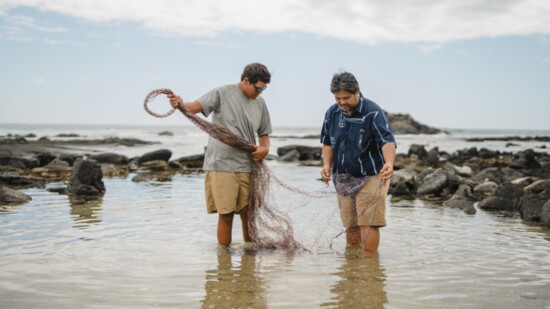Sitting at the beach in Kailua-Kona with the wind in his face, the ocean in the distance, and the smell of saltwater in the air takes Apolonio ‘Apo’ Kalani Aquino Sr. to a place of peace. He soon takes out a synthetic fishing line and begins to tie dozens of knots to create what will eventually become a large fishnet.
Apo, now 61 years old, holds this knowledge of fishnet-making close to his heart and his identity; for him, fishnet-making is a way to ensure that the past knowledge and culture of his Hawaiian heritage stay alive in today’s world. “It’s really honoring my ancestors,” he says.
“The net is like our escape and quiet time for us,” says Apo. Born and raised in Kailua-Kona, Apo has seen the town evolve into a bustling city on the Big Island’s west side.
“Kona was very much a fishing village,” he says. Apo learned how to make fishnets from his father. He would also watch his uncles sew their fishnets at Honokōhau Beach.
Apo passed his fishnet-making knowledge to his son, who was his first student. He started making the nets full-time a little over 15 years ago, saying it has become like therapy to him.
“Everything can just go away, and I’ll just focus on making my net, and getting it completed,” he says.
In 2015, Apo and his wife Stephanie moved to the Island of Molokaʻi where he taught students how to make fishnets. They lived there for five years before returning to Kona. Apo says the people on Molokaʻi are very much like how Kona used to be, in the sense that they are very into fishing.
While teaching students how to make the nets, Apo educates them on how Native Hawaiians used to create and throw nets in the past, ensuring that the culture and history of the people of Hawaiʻi can be passed on to the younger kids.
“I can talk about throw-netting but I can’t take the credit. I have to give the full credit to all those before me as throw net makers,” says Apo. “It’s not starting with me. I’m just carrying the torch onto the next generation. But it was passed on from the generations before me.”
Apo says that out of the hundreds of students he’s taught – children and adults – only about two can make a net from start to finish.
Traditionally, fishnets have been used by Native Hawaiians to catch food. Making the nets by hand is a long and tedious process that requires patience and mathematical skills. “Basically, I tie knots,” says Apo.
First, one must get their fishing line and begin to tie knots around the center or piko to create the maka or eyes. A spacer tool can be used to measure each eye. This process will form a big circle that will be thrown into the ocean to catch the fish. So, the bigger the circumference of the circle, the more knots or eyes need to be added. Working on a net full-time typically takes one to three months to complete.
“Starting it is one thing. But we all know in life, to finish something takes focus to get it done,” says Apo. His nets typically sell for around $1,300. In recent years, he has seen the desire for fishnets start to be used for a different purpose: as art.
In December 2021, Apo and his wife opened a pottery store called Kona Town Hui. He has begun to incorporate the fishnets into art by imprinting the design onto the pottery pieces or even making nets to hang in people’s homes.
“I can see people not wanting to get a throw net because the fish in the ocean is not as abundant,” he says. “As far as net making, it took me a little while to imagine it being an art. But people say that all the time. That it’s an art, and throwing the net is an art too.”
Using the fishnet for art has opened Apo’s eyes to how he can still perpetuate the culture on something that can last for decades.
“For now, I’m leaning a lot towards making more art pieces so that it can be perpetuated and left, so people go ‘It might have been made in the year 2024, but it looks like it was made in the 1800s.’”
Yet, no matter the use, Apo continues to create these fishnets to keep past knowledge and cultures alive for future generations.
Learn more at KonaTownHui.com.
It’s really honoring my ancestors.
I’m just carrying the torch onto the next generation.
